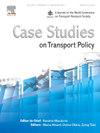Is exclusive motorcycle lane an effective strategy to enhance the operational and safety performance of rural highways?
IF 3.3
Q3 TRANSPORTATION
引用次数: 0
Abstract
Previous research has highlighted that segregating motorcyclists from the main traffic stream by providing dedicated lanes reduces the likelihood of crashes. The study evaluates the operational and safety performance of an exclusive motorcycle lane (EMCL) using link performance functions and traffic conflict techniques. However, EMCLs are not currently operational in India; thus, temporary implementations of EMCLs were conducted on rural highways to collect field data. A simulation model was developed, calibrated, and validated for EMCLs, mixed vehicle lanes, and scenarios without EMCLs to augment the data. Link performance functions were developed and optimised to determine the optimum volume-capacity (V-C) ratio. From the study, lower optimum V-C ratios were observed on roads with EMCLs (0.588 and 0.598) compared to those without EMCLs (0.852 and 0.698), indicating an increase in the level of service. Additionally, a safety analysis of EMCLs was carried out to assess conflict severity using surrogate safety measures (SSMs). The interactions between different vehicles were investigated and categorised into critical, mild, and safe based on SSM. The results indicate that implementing EMCLs improves the safety of motorcyclists and other road users by reducing critical interactions by 42%. Overall, the research showed that the motorcycle segregation strategy enhances rural highways’ operational and safety performance. The key findings of this study will provide valuable insights for transport planners, researchers, policymakers, and government agencies.
摩托车专用道是提高农村公路运营和安全性能的有效策略吗?
先前的研究强调,通过提供专用车道,将摩托车手与主要车流隔离开来,可以减少撞车的可能性。本研究利用链路性能函数和交通冲突技术对摩托车专用车道(EMCL)的运行和安全性能进行了评估。然而,emcl目前还没有在印度投入使用;因此,在农村公路上临时实施了emcl,以收集现场数据。针对emcl、混合车道和无emcl的场景,开发、校准和验证了仿真模型,以增强数据。开发并优化了链路性能功能,以确定最佳的容量-容量(V-C)比。从研究中可以看出,与未安装emcl的道路(0.852和0.698)相比,安装emcl的道路的最佳V-C比(0.588和0.598)较低,表明服务水平有所提高。此外,对emcl进行了安全性分析,使用替代安全措施(SSMs)评估冲突严重程度。研究了不同车辆之间的相互作用,并根据SSM将其分为严重、轻度和安全。结果表明,通过减少42%的关键互动,实施emcl可以提高摩托车手和其他道路使用者的安全性。总体而言,研究表明摩托车隔离策略提高了农村公路的运营和安全性能。本研究的主要发现将为交通规划者、研究人员、政策制定者和政府机构提供有价值的见解。
本文章由计算机程序翻译,如有差异,请以英文原文为准。
求助全文
约1分钟内获得全文
求助全文

 求助内容:
求助内容: 应助结果提醒方式:
应助结果提醒方式:


